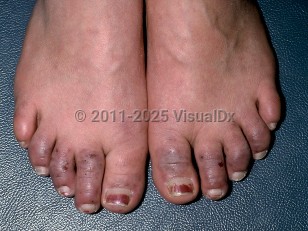Raynaud phenomenon - Nail and Distal Digit
See also in: OverviewAlerts and Notices
Important News & Links
Synopsis

Primary Raynaud phenomenon typically follows a less severe course than secondary Raynaud phenomenon. In primary Raynaud phenomenon, also termed Raynaud disease, vasospasm is not associated with ischemic injury or an underlying associated disease. Primary Raynaud phenomenon typically presents at a younger age (< 30 years), involves all fingers symmetrically excluding the thumbs, and is not painful. Patients do not have a history of peripheral vascular disease or ischemic injury. Antinuclear antibody titers are normal or low (< 1:40 on indirect immunofluorescence) and nail fold capillaries are normal.
Secondary Raynaud phenomenon is associated with an underlying disease, usually a connective tissue disease, of which systemic sclerosis is the most common. Because vasospasm is associated with concurrent ischemia, attacks are typically painful and asymmetric involvement of digits or hands is common. Digital ulcerations or necrosis, digital tuft pits, pterygium inversum, and tortuous nail fold capillaries with capillary dropout may be seen.
Additional associations include systemic lupus erythematosus, rheumatoid arthritis, pulmonary hypertension, frostbite, hematologic malignancies, polyvinyl chloride exposure, cryoglobulinemia, reflex sympathetic dystrophy, repeated trauma / vibration, arteriovenous fistula, intra-arterial drug administration, thoracic outlet syndrome, thromboangiitis obliterans, and Takayasu arteritis.
Codes
I73.00 – Raynaud's syndrome without gangrene
SNOMEDCT:
266261006 – Raynaud's phenomenon
Look For
Subscription Required
Diagnostic Pearls
Subscription Required
Differential Diagnosis & Pitfalls

Subscription Required
Best Tests
Subscription Required
Management Pearls
Subscription Required
Therapy
Subscription Required
Drug Reaction Data
Subscription Required
References
Subscription Required
Last Updated:10/08/2024
 Patient Information for Raynaud phenomenon - Nail and Distal Digit
Patient Information for Raynaud phenomenon - Nail and Distal Digit- Improve treatment compliance
- Reduce after-hours questions
- Increase patient engagement and satisfaction
- Written in clear, easy-to-understand language. No confusing jargon.
- Available in English and Spanish
- Print out or email directly to your patient


